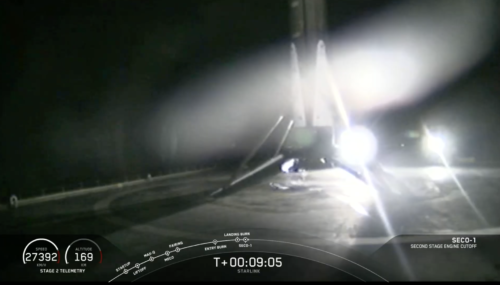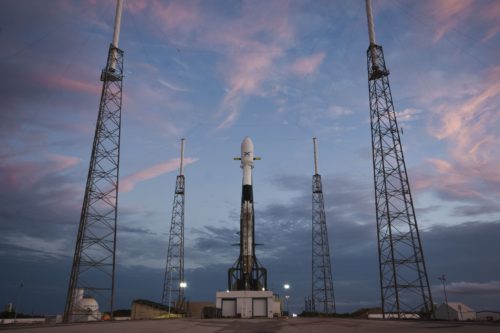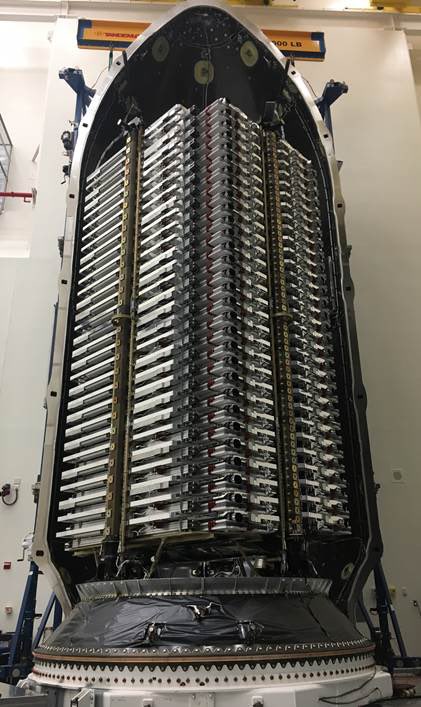
Sixty more Starlink satellites and the second Falcon 9 core to be used as many as four times are ready to kick off 2020, a year which marks a full decade since SpaceX began flying the earliest iteration of this highly successful fleet of boosters. It was way back in June 2010 that the first Falcon 9 rose ponderously from Space Launch Complex (SLC)-40 at Cape Canaveral Air Force Station, Fla., carrying a boilerplate qualification unit for SpaceX’s Dragon cargo ship.
Since then, the fleet has evolved through several generations, completed 79 successful missions—including three flights by the mammoth Falcon Heavy—and achieved landings on the decks of oceangoing drone ships and on solid ground. On Monday, SpaceX will attempt to meet an “instantaneous” launch window to put another 60 of its Starlink internet communications satellites into orbit.

Seen after completing its third Autonomous Spaceport Drone Ship (ASDS) landing in May 2019, B1049 is slated for a fourth oceanic touchdown on Monday night. This promises to make it the first Falcon 9 core to achieve four ASDS landings. Photo Credit: SpaceX
Less than a week into the new decade, at 9:19 p.m. EST Monday, SpaceX anticipates its busiest year to date will get underway with the fourth launch of Falcon 9 core B1049. This particular core previously saw service to boost the Telstar 18V communications satellite to geostationary altitude in September 2018, followed by the final set of ten Iridium NEXT global mobile communications satellites in January 2019 and, most recently, the first group of 60 Starlinks last May. B1049 has achieved three landings on the Autonomous Spaceport Drone Ship (ASDS)—twice on the East Coast-based “Of Course I Still Love You” and once on the West Coast-based “Just Read the Instructions”—but fell short of becoming the first Falcon 9 core to log four launches. That accolade belongs to its sister B1048, which wrapped up its fourth flight last year.
Each first-stage core of the currently-in-service Block 5 Falcon 9 is advertised as being capable of flying up to ten missions. The first reflight came in March 2017 and since then more than 20 cores have completed two launches, of which five went on to fly on a third occasion and one so far (B1048) has completed a fourth. Blackened and scarred from its three previous launches and high-energy re-entries, B1049 was transported from the Horizontal Integration Facility (HIF) to SLC-40 for the customary Static Fire Test of its nine Merlin 1D+ engines on Saturday, 4 January. Following the successful completion of the test, the booster was returned to the HIF for the installation of its payload fairing and its primary payload.

B1049 will become only the second Falcon 9 core to be flown four times. Photo Credit: SpaceX/Twitter
And the primary payload for the first U.S. space launch of the 2020s is another 60 of SpaceX’s homegrown (and highly controversial) Starlink low-orbiting internet communications satellites. This $10 billion program was described by SpaceX CEO Elon Musk as a means of revolutionizing low-cost broadband provision and was unveiled during an event in Seattle, Wash., back in January 2015. Mr. Musk identified Starlink as a means of opening the way for competitively-priced services for urban regions and rural and underserved areas of the United States. Under the announced plan, an eventual network of 12,000 satellites could handle up to half of all backhaul communications traffic and a tenth of all local internet traffic in high-population-density cities.
Late in 2016, SpaceX described the concept as “non-geostationary” and revealed Starlink’s initial coverage would span the Ku-band and Ka-band regions, between 12-18 GHz and 26.5-40 GHz, respectively. By the late spring of the following year, plans were laid for a second orbital “shell” of satellites to utilize the V-band at 40-75 GHz, which is not routinely used for commercial communications purposes. Previously, the V-band has seen service for millimeter-wave radar research and scientific applications, but it reportedly also has promise for high-capacity terrestrial millimeter-wave communications networks.

Launched in batches of 60, Starlink missions were previously accomplished in May and November 2019. Photo Credit: SpaceX/Twitter
SpaceX’s original intent was for 4,425 Ku-/Ka-band Starlinks to reside at an altitude of 710 miles (1,150 km) and 7,518 V-band birds to sit at 210 miles (340 km), producing a total population of these small satellites by the mid-2020s. However, in November 2018 SpaceX received licensing from the Federal Communications Commission (FCC) to operate a third of the Ku-/Ka-band complement—some 1,584 satellites—at just 340 miles (550 km), much lower than initially planned. This will produce a relatively short operational lifetime of around five years, before they are maneuvered into a disposal orbit for controlled re-entry. SpaceX has explained that all satellite components are “100-percent demisable” and exceed “all current safety standards”, but the sheer volume of Starlinks to be launched in a relatively short period has aroused lingering controversy, both in terms of the work of astronomers and adding to ongoing debate about the effect of space debris.
Two Starlink test satellites, Tintin-A and Tintin-B, were launched in February 2018 and successfully validated the phased-array broadband antenna from an orbital perch 320 miles (515 km) above Earth. Then, last May, the first 60 “production” Starlink satellites were launched atop B1049. Although three of the satellites failed shortly after reaching orbit, the remainder are still healthy. More recently, in November 2019, another 60 Starlinks were boosted to space on the record-breaking fourth launch of B1048.

Like a gigantic pack of cards, the 60 Starlink satellites prove a “tight fit” in the Upgraded Falcon 9 payload fairing, according to SpaceX CEO Elon Musk. This image was taken from the first Starlink batch of satellites, which flew earlier in 2019. Photo Credit: Elon Musk/SpaceX/Twitter
SpaceX President Gwynne Shotwell has already confirmed plans to launch further 60-strong sets of Starlinks approximately every two weeks throughout 2020, raising the likelihood that many hundreds of these small satellites will be in orbit by next New Year’s Eve. Assuming an ambitious 24 Starlink launches, it is also envisaged that SpaceX will stage more than a dozen missions for other customers, including the first manned Crew Dragon missions, the first cargo Dragons under the second-round Commercial Resupply Services (CRS2) contract with NASA and three Global Positioning System (GPS) Block III satellites.
Weather conditions for Monday night’s opening launch attempt are predicted to be around 90-percent favorable, according to the 45th Weather Squadron at Patrick Air Force Base. “Strong high pressure will build across the south-eastern U.S. on Sunday, is forecast to be centered across Florida by Monday night,” it was noted in the L-4 weather briefing late Thursday, 2 January. “This will bring dry conditions and light northerly flow for the primary launch window.” Principal concerns for Monday is a possible violation of the Cumulus Cloud Rule. A 24-hour scrub to Tuesday will see the weather outlook deteriorate to about 80-percent favorable, with a moistening south-westerly flow bringing with it the possibility of additional cloud cover.
.
.
FOLLOW AmericaSpace on Facebook and Twitter!
.
.





“Following the successful completion of the test, the booster was returned to the HIF for the installation of its payload fairing and its primary payload.”
The payload was integrated for the static fire. The rocket has been vertical since then and has not left the pad.